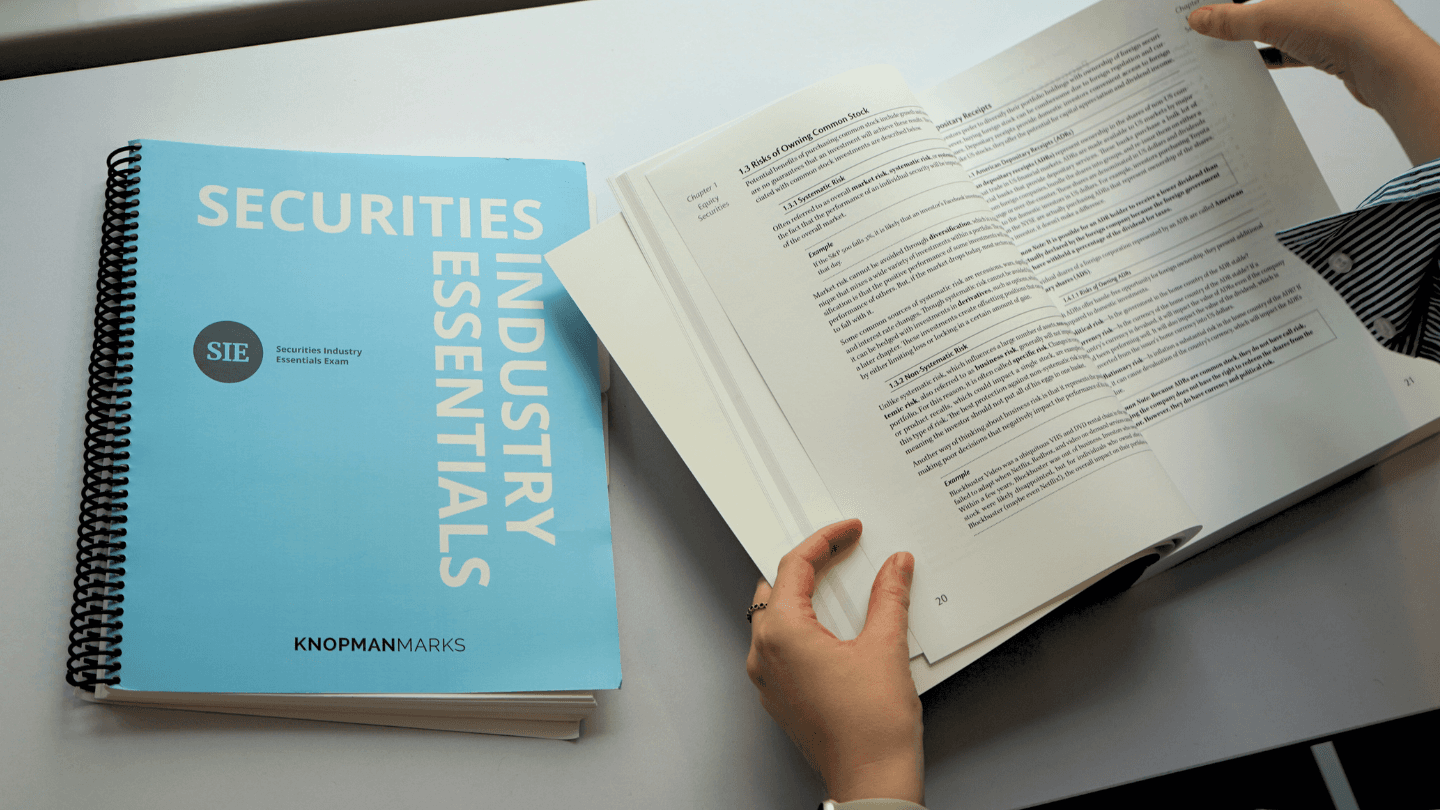Market Order vs. Limit Order vs. Stop Order: What’s the Difference?
Filed in: Knopman News, SIE Exam

Orders are directions, or instructions, that investors give for purchasing and selling stock. Different order types allow investors to decide under which conditions a purchase or sale will go through and thus achieve better control of the price they pay or receive.
The SIE Exam expects candidates to demonstrate a basic understanding of market, limit, and stop orders and the strategies they accomplish. Several questions on order types and strategies typically appear on the SIE Exam.
How Market Orders Work
Market orders are the most common and simplest type of order. If a customer requests a purchase or sale of stock to be executed now, the customer has entered a market order. The order indicates that the customer is willing to buy or sell the stock at the current market price—whatever it may be. The order will be entered and filled immediately.
What Is a Limit Order?
Like the name implies, limit orders allow customers to set boundaries on the price at which they will buy or sell stock. When using these orders, customers designate a price limit, and the order will execute only at that price or better.
Because they can’t be executed immediately, limits are held on the order book, which is the electronic log of buy and sell orders for a particular stock that cannot be executed at the current price. The order book also shows the market makers in the stock and their market size, or the number of shares they have available at that price. The number of shares (and their prices) that are offered for sale by market makers make up the ask side of the book, while the number of shares (and prices at which) market makers will buy is the bid side. The total amount of shares that are available for purchase and sale as shown by the order books is the depth of market for that stock.
Market orders are not held on the order book because they are immediately executable. But limit orders are held on the order book until the target price is available.
Let’s break down the difference between buy and sell limit orders. A buy limit order is entered by investors that would like to purchase a particular stock, but only at a better price – one that is lower – than its current market value. For example, a buy limit order is entered at 35 when the stock is trading at 36; this order will execute only if the price of the stock equals or falls below 35.
Exam questions often list a sequence of prices and ask you to determine the first price at which order execution will occur.
Sample Question:
If an investor enters a buy limit at $42.25, at which of the following prices will the order be executed?
Choices: $42.45 | $42.30 | $42.20 | $42.25
Explanation: The buy limit order will execute at $42.20, since this is the first price at or below the buyer’s limit price.
A sell limit order will execute at the stated price or higher. Investors that use these orders are willing to sell stock, but only at a price that is better – or greater – than the current market price.
Sample Question:
An investor enters an order to sell ABC stock at $54.50 per share. If the stock is currently trading at $54.10, at which of the following prices will the order be executed?
Choices: $54.15 | $54.45 | $54.53 | $54.50
Explanation: This sell limit order will execute at $54.53, since this is the first price at or above the seller’s limit price.
The risk of limit orders is that execution isn’t guaranteed. Also, if the target price is reached, the full order may not be filled, depending on the number of shares that are available at the limit price.
How Stop Orders Work
Stop orders are also known as “stop loss” orders. This alternative name comes from their role in the protection of an investor’s stock position – be it long or short. A stop order has two parts: a trigger (or election) and an execution. We’ll identify these two parts through examples of how these orders are used.
Protecting Long Positions with Stop Orders
Our first example involves an investor with a long stock position – in other words, the investor owns stock and profits if the market goes up. The risk is that the market may fall below what was paid for the stock or that profit made from holding the stock may be lost. This is where a stop order is beneficial. By placing a sell stop order below the current market price, the continued gain from rising prices isn’t impacted, but if the position starts losing value, the stock can be sold to protect against a significant loss.
Sample Question:
An investor is long stock that is currently trading at 64. The investor bought the stock at 50 and believes the market still has substantial upside. Just in case, however, the investor would like to protect some of the profit as well as protect against significant loss. Which of the following orders would best protect this position?
- Buy limit at 62
- Sell limit at 63
- Buy stop at 63
- Sell stop at 62
The correct answer is D. This investor has an unrealized gain of $14 per share and can use a sell stop order at 62 to protect some of it. With this order, the upside potential of the stock is not interrupted, but if the market turns down, the investor can sell the stock to protect as much of the $12 gain as possible.
The stop loss order is placed below the current market value and is triggered at the first price at or below the trigger price of 62. Once the order is triggered, it becomes a market order, which means it executes at the next price at or below the order price.
Sample Question:
Assume a sell stop order at 62. At which price is the order elected? At which price is it executed?
Choices: $64 | $63.15 | $61.95 | $61.85 | $62
Explanation: This sell stop order will be triggered (elected) at $61.95, the first price at or below the order price. It then becomes a market order, so it will execute at the next price – $61.85. As you can see, the risk of this order is that it could execute below the stop price stated in the order.
The investor could further qualify the order by making it a sell stop limit. In this case, it is still triggered at the first price at or below the order price, but it then executes only at the limit price of 62 or better. Here, execution happens at $62, since that is the first price at or above the seller’s limit price. Remember, a better price for a seller is a higher price, so a price of 62 or above would be executable.
Although the stop limit order helps the investor ensure a better sales price, its risk is that it may be triggered but never executed. For example, had the stock price continued to fall after triggering at $61.85, the investor’s order would not have executed.
Protecting Short Positions with Stop Orders
In a short position, an investor has borrowed stock from a broker-dealer and sells the borrowed shares to a buyer at the highest possible price. The investor must return the borrowed stock to the lender and hopes to purchase the shares at the lowest possible price to do so. The investor is bearish and profits if the stock’s price declines.
Sample Question:
An investor sold 100 shares of XYZ stock short at 45. How can the investor best protect this position?
- Buy limit at 46
- Sell limit at 44
- Buy stop at 46
- Sell stop at 43
The correct answer is C. This investor will lose money when the stock must be repurchased above the price of the short sale. By entering a buy stop order at 46, the investor will have the opportunity to purchase the stock if the market hits or goes above the price of 46, limiting the potential purchase price for buying in the borrowed shares.
In this situation, the order is placed above the current market and is triggered at the first price at or above the order price of 46. Once the order is triggered, it becomes a market order, which means it executes at the next price.
Sample Question:
Assume a buy stop order at 62. At which price is the order elected? At which price is it executed?
Choices: $61.95 | $62.10 | $62.25 | $62.15 | $62.10 | $61.95
Explanation: This buy stop order will be triggered (elected) at $62.10, the first price at or above the order price. It then becomes a market order, so it will execute at the next price – $62.25.
The investor could further qualify the order by making it a buy stop limit. If so, it is still triggered at the first price at or above the order price – $62.10 – but then executes only after the price drops below $62 to $61.95, since this is the first price at or below the buyer’s limit price. Remember, a better price for a buyer is a lower price, so a price of 62 or below would be executable.
Stock Order Types: Key Points
- A market order offers the greatest certainty of execution but offers no control over the transaction price.
- Buy limit orders are placed below the market price – a low price is a better price for the buyer.
- Sell limit orders are placed above the market price – a high price is a better price for the seller.
- Stop orders become market orders when triggered, executing at whatever the next price is.
- Stop limit orders become limit orders when triggered, executing only at a price equal to or better than the limit price. A risk is that these orders may never be executed if the market doesn’t hit the limit price.
- Buy stop orders are placed above the market price – a protective strategy for a short stock position. These orders will be triggered at the first price at or above the order price.
- Sell stop orders are placed below the market price – a protective strategy for a long stock position. These orders will be triggered at the first price at or below the order price.
Now that you know the basics of these orders, you’ll need to practice questions to master them for the SIE Exam. Be sure to read questions and explanations carefully so you get the most out of your practice time.
Written by Marcia Larson
Marcia Larson is Vice President, Faculty, at Knopman Marks Financial Training, New York, NY. She has extensive experience in financial licensing and regulatory training, having authored, developed and presented courseware for numerous securities and insurance exam preparation and continuing education and compliance programs. Before joining Knopman Marks, Marcia was Director of Annuity Products and Business Development at CUNA Mutual Group, where she developed and marketed industry-leading annuity products and retirement solutions and implemented distribution relationships. She was previously VP, Securities Products for Kaplan Financial, managing securities training products and subsequently, international training and businesses development. Marcia has trained thousands of financial industry exam candidates throughout their careers, and also college students as an adjunct professor. Marcia was a summa cum laude graduate of Wartburg College with degrees in Business Administration and Piano Performance. Marcia also holds the designations of Chartered Financial Consultant® (ChFC®), Chartered Life Underwriter (CLU®), Certified Employee Benefit Specialist (CEBS), and Fellow Life Management Institute™ (FLMI®). She currently teaches the SIE, Series 6, 7, 24, 50, 52, 63, 65, and 66 exams.
Related posts
- Read more
Crush the SIE Exam with the Video Vault
Are you feeling overwhelmed by the sheer volume of Securities Industry Essentials (SIE) exam cont
- Read more
Why Should I Take the SIE Exam in College?
In the era of asynchronous learning college students are turning to various self-study methods an
- Read more
Crush the SIE: Download Your Free Practice Exam
Are you eager to begin a career in finance but don’t know where to start taking the first steps?


